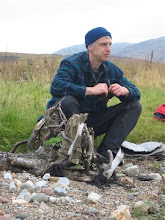 After a week away on holiday I went out to the Moss to get a feel for it again for one of the scheduled hen harrier counts. So an hour spent over sunset in the tower on a gloriously still, crisp, clear and very, very cold evening was perfect. It was so still that any utterance by any bird for hundreds of yards around could be heard. A couple of cock pheasants tried to outdo one another, a distant carrion crow shouted from a tree top and a couple of ravens cronked like distant laughter. Then the silence was shattered as a microlight took off from Easter Poldar airfield. The pilot must have had a truly amazing view but I wonder if he ever wondered what the effect of the racket the machine makes has on others. Once the sun dipped below the horizon deer wraiths appeared on the moss. Roe deer were betrayed by their white bums, red deer materialised out of the scrub edge, first 1, then 3 then 12 before it was too late to see. And then it was time with no hen harriers seen again. They are still using the moss but just haven't been seen on the last two official counts. I headed back to the truck and started down the track before pulling up. There against the navy blue sky were several hundred jackdaws and rooks wheeling around, splitting and joining like a group of big clumsy starlings. Just a small group compared with most roosts these birds were going through their daily preparations for roosting where they fly group aerobatics and call their heads off before heading to the tree tops for the night. A book called Crow Country by Mark Cocker that I read recently describes it far better and in more detail than I ever could if you wanted to know more. Some of the best sights of the day can be from everyday common birds that you might normally ignore.
After a week away on holiday I went out to the Moss to get a feel for it again for one of the scheduled hen harrier counts. So an hour spent over sunset in the tower on a gloriously still, crisp, clear and very, very cold evening was perfect. It was so still that any utterance by any bird for hundreds of yards around could be heard. A couple of cock pheasants tried to outdo one another, a distant carrion crow shouted from a tree top and a couple of ravens cronked like distant laughter. Then the silence was shattered as a microlight took off from Easter Poldar airfield. The pilot must have had a truly amazing view but I wonder if he ever wondered what the effect of the racket the machine makes has on others. Once the sun dipped below the horizon deer wraiths appeared on the moss. Roe deer were betrayed by their white bums, red deer materialised out of the scrub edge, first 1, then 3 then 12 before it was too late to see. And then it was time with no hen harriers seen again. They are still using the moss but just haven't been seen on the last two official counts. I headed back to the truck and started down the track before pulling up. There against the navy blue sky were several hundred jackdaws and rooks wheeling around, splitting and joining like a group of big clumsy starlings. Just a small group compared with most roosts these birds were going through their daily preparations for roosting where they fly group aerobatics and call their heads off before heading to the tree tops for the night. A book called Crow Country by Mark Cocker that I read recently describes it far better and in more detail than I ever could if you wanted to know more. Some of the best sights of the day can be from everyday common birds that you might normally ignore.


